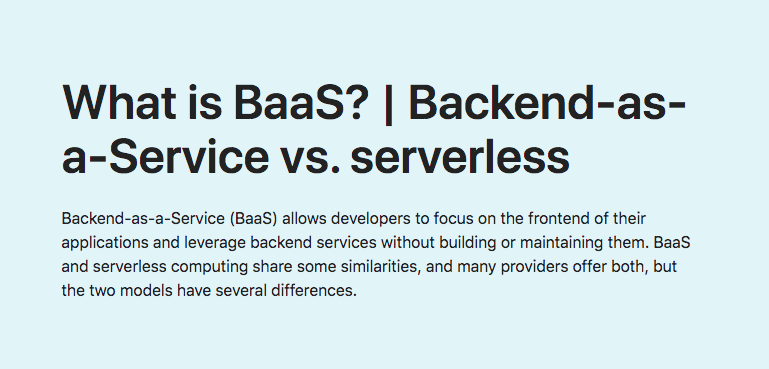Backend-as-a-Service (BaaS) enables developers to concentrate on the frontend of their apps while utilising backend services that they do not have to build or manage. Although there are some parallels between BaaS and serverless computing, and many providers provide both, the two models differ in key ways.

Learning Objectives
After reading this article you will be able to:
- Define BaaS
- Define MBaaS
- Understand the differences between serverless computing and BaaS
- Understand how BaaS and PaaS are different
What is BaaS?
Backend-as-a-Service (BaaS) is a cloud service paradigm in which developers outsource all of the backend components of a web or mobile application, leaving them with only the frontend to build and manage. Pre-written software for server-side operations such as user authentication, database administration, remote updating, and push notifications (for mobile apps), as well as cloud storage and hosting, is provided by BaaS providers.
Consider building an application without a BaaS provider to be similar to directing a film. In addition to actually filming and directing the sequences that will appear in the film, a film director is responsible for coordinating or managing camera crews, lighting, set building, wardrobe, actor casting, and the production timeline. Imagine if there was a service that handled all of the behind-the-scenes tasks so that the filmmaker could focus on directing and shooting the sequence. The concept behind BaaS is that the vendor handles the “lights” and “camera” (or, server-side* functions) so that the director (the developer) may focus on the “action” – what the end user sees and feels.
Developers may concentrate on building frontend application code with BaaS. They can incorporate all of the backend functionality they require using APIs (a means for a programme to make a request of another programme) and SDKs (software development kits) provided by the BaaS vendor, without having to create the backend themselves. They also don’t have to worry about managing servers, virtual machines, or containers in order to keep the programme operating. As a result, they will be able to create and launch mobile and web apps (including single-page applications) more quickly.
*In the Internet client-server architecture, server-side refers to everything that is housed on or takes place on a server rather than on a client.
What is Mobile-Backend-as-a-Service (MBaaS)?
Mobile-Backend-as-a-Service (MBaaS) is a kind of BaaS designed particularly for developing mobile apps. While some sources regard the words BaaS and MBaaS to be almost identical, BaaS services are not required to be employed in the development of mobile apps.
What is included in BaaS?
BaaS providers offer a number of server-side capabilities. For instance:
- Database management
- Cloud storage (for user-generated content)
- User authentication
- Push notifications
- Remote updating
- Hosting
- Other platform- or vendor-specific functionalities; for instance, Firebase offers Google search indexing
BaaS and MBaaS providers include Google Firebase and Microsoft Azure.
Related Posts
- 2021 Edge Computing Forecast, Trends & Market Size
- Edge Computing, Cloud Computing & Fog Computing
- Talking about MEC Mobile Edge Computing
- Top Ten Digital Transformation Trends: 5G, Artificial Intelligence, Telecommuting…
What are the differences between BaaS and serverless computing?
Because the developer simply needs to write their application code and doesn’t have to worry about the backend, there is some overlap between BaaS and serverless computing. Many BaaS vendors also provide serverless computing services. There are, nevertheless, substantial operational differences between BaaS-based apps and truly serverless architectures.
How the application is constructed
Serverless applications’ backends are divided into functions, each of which reacts to events and takes just one action (see What is FaaS?). Meanwhile, BaaS server-side features are built according to the provider’s specifications, and developers don’t have to worry about writing anything other than the application’s frontend.
When code runs – Serverless architectures
Serverless architectures are event-driven, which means they are triggered by external events. Each function is only activated when it is triggered by a certain event; otherwise, it is not activated. Because BaaS applications are typically not event-driven, they demand more server resources.
Where does code execute? – Serverless functions
Serverless functions may be executed from any computer as long as they are still in contact with the rest of the application, allowing edge computing to be included into the program’s architecture by running code at the network’s edge. BaaS isn’t always set up to run code from any location, at any time (although it can be, depending on the provider).
How the application scales
One of the most important characteristics that distinguishes serverless systems from other types of architecture is scalability. When using serverless computing, the application scales up as the number of users grows. The architecture of the cloud vendor spins up ephemeral instances of each function as needed. Unless the BaaS provider also offers serverless computing and the developer incorporates it into their application, BaaS applications are not set up to grow in this fashion.
What is the difference between BaaS and Platform-as-a-Service (PaaS)?
PaaS is a cloud-based platform that allows developers to construct apps. Platform-as-a-Service (PaaS), like serverless computing and BaaS, eliminates the requirement for the developer to construct and manage the application backend. PaaS, on the other hand, excludes server-side application functionality like push notifications and user authentication. PaaS provides greater freedom to developers, whereas BaaS provides more functionality. Additionally, you can view the 7 Factors why PaaS is the Future of Cloud Computing today.
RELATED CONTENT
- What Is the Cloud?
- What Is Hybrid Cloud?
- What is Cloud Migration?
- What Is a Cloud Firewall?
- What Is Multicloud?
- What is SaaS (Software-as-a-Service)?
- What is PaaS (Platform-as-a-Service)?
- Serverless Computing vs. Containers | How to Make a Decision